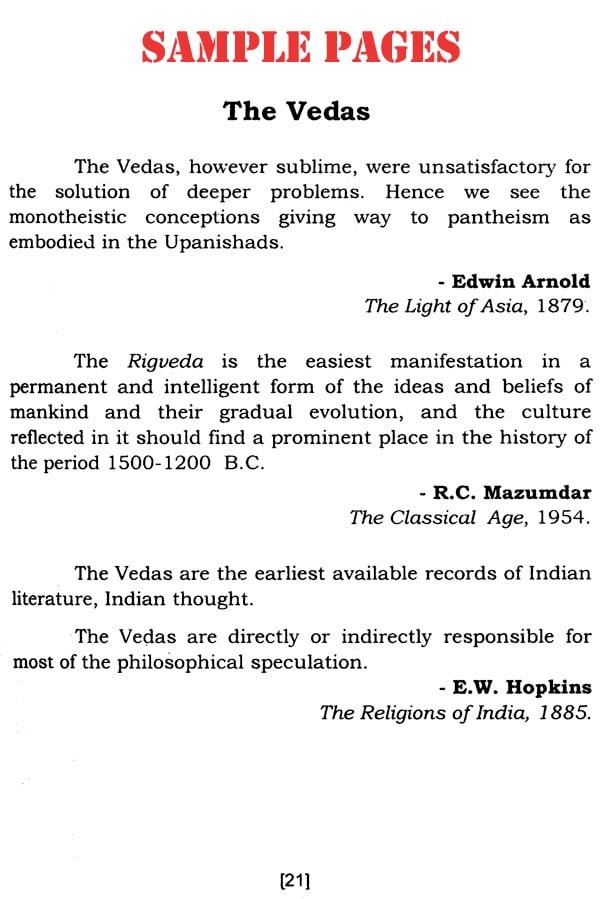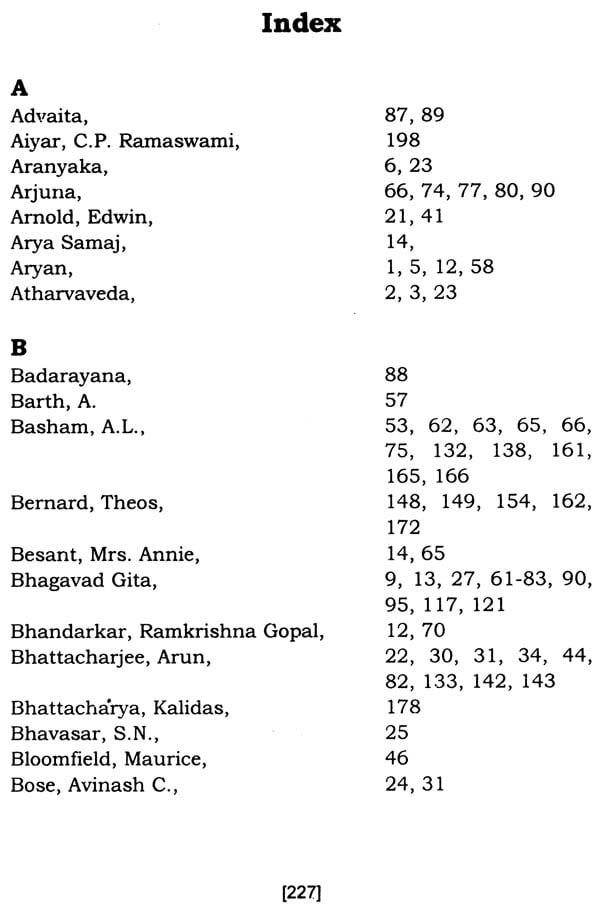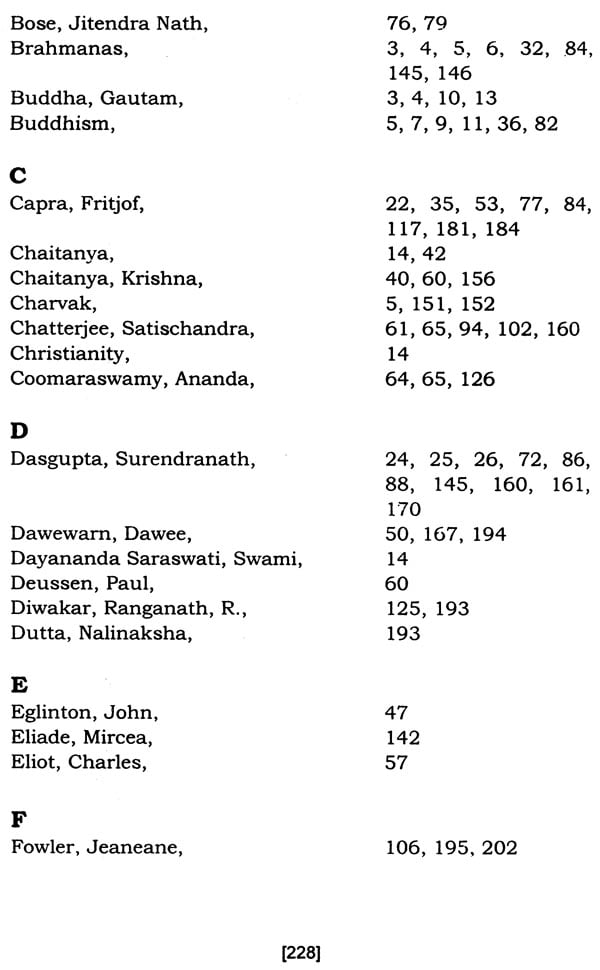
The Treasury of Hinduism (Selected Book of Quotations)
Book Specification
| Item Code: | NAO980 |
| Author: | Harischandra Lal Singh |
| Publisher: | Robin Books |
| Language: | English |
| Edition: | 2002 |
| ISBN: | 9798187138562 |
| Pages: | 242 |
| Cover: | PAPERBACK |
| Other Details | 8.50 X 5.50 inch |
| Weight | 300 gm |
Book Description
The Treasury of Hinduism is a compilation of quotations from the writings of eminent as well as celebrated writers, thinkers, philosophers and other distinguished men in different walks of life.
Containing as it does a brief historical survey of the development of Hinduism including its chronology, bibliography, glossary, etc, the book is intended to give a true picture of Hinduism, a great religion, from the Eastern as well as Western viewpoints.
The main purpose of this book is to make an objective presentation of the philosophy of Hinduism through the voice of thinkers and philosophers. It is believed that this book will provide an opportunity to the readers to see for themselves what Hinduism is.
Starting with journalism as career, Mr. Singh, the compiler of this book, has written a number of books on Buddhism. He is presently involved in Buddhist research.
Philosophy, religions or metaphysics is not my field. It is simply my academic interest. Having spent creamy part of my life in the field of journalism, philosophy and religion came into my life as a craze to fulfil the spiritual aspiration which journalism could not.
My lesson in philosophy started with the study of lives of saints and sages beginning with Swami Sivananda, Vivekananda, and Shivapuri Baba etc. Bhawan Book's publication, books of Paul Brunton and writings of Swami Vivekananda were stepping stones to my philosophic quest. The Buddha came to my life in only 1970's only years after my coincidental visit to Sri Lanka in 1977, the year when the air service between Nepal and Sri Lanka were inaugurated. I was a member of the journalist team to cover the inaugural event. From 1980's onwards, Buddhism became a part of my life, an integral part, not even a single day passed in my life without remembering the outstanding contribution of the Buddha to the mankind and without being filled with the aura of magnetic personality of the Buddha. In order to understand Buddhism in a fuller manner, I have to make a comparative study of Hinduism and other world religions.
The present book is an outcome of my study of Hinduism. Whenever I read books, I make notes. The notes increased in number thus paving way to this work.
Hinduism is so many things to so many people. To quote Dr. Fritjof Capra, it is a large, and complex social religious organism consisting of innumerable sects, cults, and philosophical systems and involving various rituals, ceremonies and spiritual disciplines, as well as the workshop of countless gods and goddesses."
Hinduism, a product of great culture and civilization, has made tremendous impact on the philosophy and thought of the world as a whole.
It is, as scholar D.S. Sharma has observed, "a highly practical as well as a highly philosophical religion".
The quotations given in this book better explain as well as demonstrate what Hinduism is in the true sense of the term. If this book serves the purpose, I feel myself amply rewarded.
Though Hinduism is only a new coinage, it has become customary to include the Vedas, Upanishads, the Puranas, the Ramayana, the Mahabharata, and other philosophical systems that were developed in various ages within the fold of Hinduism. This has made it very difficult to define Hinduism in concrete and categorical terms. Therefore, when we trace the development of Hinduism, we naturally start with the Vedic age which has exerted a decisive influence in Indian cultural and philosophical history. Vedic Samhitas (collections) stand out as the origin of Hinduism.
The Vedas
The date of the Vedas is difficult to ascertain. The Vedas were handed down from mouth to mouth from a period of unknown antiquity. It was generally supposed that either they were taught by God to the sages, or were revealed to the sages.
When the Vedas were composed, there was probably no system of writing in India. The Brahmins got the whole Vedic literature by heart by hearing it form their preceptors.
The Vedas are the earliest religious literature of India. It is said that the Vedas are not human compositions but revelations from God. The mantras of the Vedas, which have been composed by different persons at different places and at different times, were collected and arranged in their present form at a certain time by a certain person or more probably by a group of persons. Who this person was, or when this great work was accomplished, cannot be ascertained.
The Aryans worshipped a specific number of deities called Devas. The hymns of the Rig Veda were mostly addressed to these Devas. These Devas were personifications of some power or of nature. Some hymns were meant for specific sacrificial purposes and some hymns were meant for chanting. Some were sung during the ritual activities. The four major Vedas are Rigveda, Yajurveda, Samaveda and Atharva Veda. The four Vedas are the richest, brightest, most magnificent heritage of the Hindus; they embody all their wisdom, poetry, metaphysics and mysticism".
Atharvaveda is the fourth Veda. It is also called Brahmaveda because it served as the manual of the chief sacrificial priests, the brahmins.
The Atharvadeda embodies the magical formulary of ancient India, and much of it is devoted to spells, incantations, chants and charms.
One of the reputed authors of the Atharva Veda was the Rishi Atharvan of Maga or Persian ancestry. The portion related to the sorcery, magic, etc was attributed to the Rishi Angiras who belonged to the Dravidian stock.
It is the most interesting part of the sruti as it has preserved a solid core of pre- Aryan and non-Aryan tradition. Some scholars believe that this Veda represents the oldest stratum of Indian liturgy and belief and embodies the creeds of the pre- Aryans.
The Rigveda is a body of hymn's to be recited. The Yujurveda is concerned with Vedic sacrifices. The Samaveda is a musical rendering of the Rigveda. The hymns of the Atharvaveda are mostly related to the affairs of daily life. These Vedas are called Samhitas (collections).
The Upanishads
The Upanishads insist on monotheism, the unity of God, Brahamana or Atman, the indwelling spirit. The deeper problems of the Upanishads originated with the Kshatriyas from whom the Brahmins learned them. While the Brahmins busied themselves with sacrifices, the ritual and gods connected with them, the Kshatriyas with their greater freedom from the bondage of tradition and ceremonialism, penetrated into the deeper mysteries of the universe.
It is a very remarkable feature of Indian religious development that in subsequent periods after the Vedas and the Upanishads and the class of literature called the Brahamanas, most of the new departures originated outside the Brahamanical circle. The greatest religious teachers and reformers were not Brahmins - the Buddha, Vardhamana Mahavir, Kabir, Nanak etc.
Contents
| Dedication | ||
| Preface | ||
| Introduction | ||
| development of Hinduism | ||
| | ||
| Chapters | ||
| 1 | The Vedas | 21 |
| 2 | The Upanishads | 38 |
| 3 | The Gita | 61 |
| 4 | The Vedanta | 84 |
| 5 | The Yoga | 94 |
| 6 | Moksha | 104 |
| 7 | Karma | 111 |
| 8 | Renunciation | 120 |
| 9 | The Ramayana | 126 |
| 10 | The Mahabharata | 130 |
| 11 | The Manusmriti | 136 |
| 12 | The Puranas | 141 |
| | ||
| 1 | Bahamanas | 145 |
| 2 | Samkhya | 147 |
| 3 | Charvak | 151 |
| 4 | Nyaya | 153 |
| 5 | Vaisesika | 156 |
| 6 | Mimansa | 157 |
| 7 | Shaivism | 160 |
| 8 | Shaktism | 169 |
| 9 | Vaishnavism | 172 |
| 10 | Indian Philosophy | 174 |
| 11 | What is Hinduism? | 181 |
| Bibliography | 205 | |
| Glossary | 216 | |
| Index of writers and subjects | 227 |











